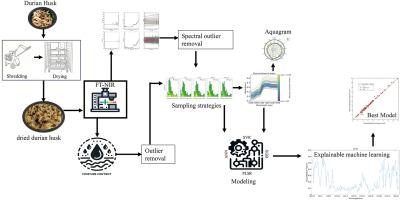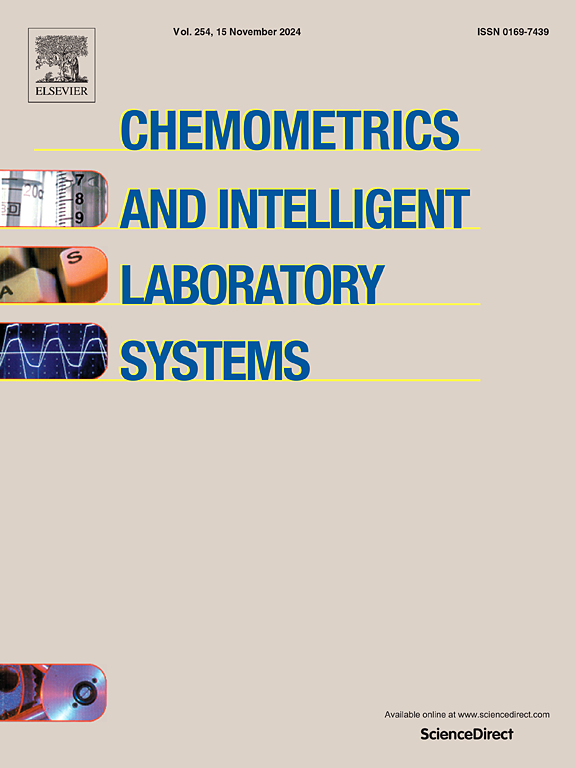Moisture content prediction in durian husk biomass via near infrared spectroscopy coupled with aquaphotomics and explainable machine learning
IF 3.8
2区 化学
Q2 AUTOMATION & CONTROL SYSTEMS
Chemometrics and Intelligent Laboratory Systems
Pub Date : 2025-09-18
DOI:10.1016/j.chemolab.2025.105538
引用次数: 0
Abstract
Accurate determination of moisture content is essential for energy efficiency and biomass management for fuel materials such as durian husk. Traditional methods of determining biomass moisture content are time-consuming and require specialized expertise, posing challenges for continuous monitoring. To address this limitation, this study applies Near Infrared Spectroscopy (NIRS) combined with machine learning models to rapidly and accurately assess moisture content. Both linear Partial Least Squares Regression (PLSR) and non-linear approaches were used, including Support Vector Machines (SVM), Artificial Neural Networks (ANN), and Extreme Gradient Boosting (XGB). The application of preprocessing techniques, notably the Savitzky-Golay second derivative (SD) and Standard Normal Variate (SNV), significantly augmented the predictive performance, highlighting the importance of data preprocessing in spectral analysis. Synthetic spectral augmentation using Gaussian noise revealed that while SVM and ANN exhibited near-perfect performance, SVM demonstrated quantifiable reliability. This study also demonstrates SVM as the most sensitive and reliable method for detecting and quantifying moisture content in durian husk. This research contributes novel insights to biomass analysis, highlighting the benefits of integrating NIRS and feasibility of explainable machine learning techniques to identify water related spectral parameters to advance aquaphotomics, thereby advancing rapid and accurate biomass characterization.

利用近红外光谱结合水光组学和可解释机器学习预测榴莲果皮生物量中的水分含量
准确测定水分含量对榴莲壳等燃料材料的能源效率和生物质管理至关重要。测定生物质水分含量的传统方法耗时长,需要专业知识,给连续监测带来了挑战。为了解决这一限制,本研究将近红外光谱(NIRS)与机器学习模型相结合,快速准确地评估水分含量。采用线性偏最小二乘回归(PLSR)和非线性方法,包括支持向量机(SVM)、人工神经网络(ANN)和极限梯度增强(XGB)。预处理技术的应用,特别是Savitzky-Golay二阶导数(SD)和标准正态变量(SNV),显著提高了预测性能,突出了数据预处理在光谱分析中的重要性。使用高斯噪声的合成谱增强表明,支持向量机和人工神经网络表现出接近完美的性能,而支持向量机表现出可量化的可靠性。本研究也证明支持向量机是检测和定量榴莲果皮含水量最灵敏、最可靠的方法。本研究为生物量分析提供了新的见解,强调了集成近红外光谱的好处和可解释的机器学习技术的可行性,以识别与水相关的光谱参数,从而推进水相学,从而推进快速准确的生物量表征。
本文章由计算机程序翻译,如有差异,请以英文原文为准。
求助全文
约1分钟内获得全文
求助全文
来源期刊
CiteScore
7.50
自引率
7.70%
发文量
169
审稿时长
3.4 months
期刊介绍:
Chemometrics and Intelligent Laboratory Systems publishes original research papers, short communications, reviews, tutorials and Original Software Publications reporting on development of novel statistical, mathematical, or computer techniques in Chemistry and related disciplines.
Chemometrics is the chemical discipline that uses mathematical and statistical methods to design or select optimal procedures and experiments, and to provide maximum chemical information by analysing chemical data.
The journal deals with the following topics:
1) Development of new statistical, mathematical and chemometrical methods for Chemistry and related fields (Environmental Chemistry, Biochemistry, Toxicology, System Biology, -Omics, etc.)
2) Novel applications of chemometrics to all branches of Chemistry and related fields (typical domains of interest are: process data analysis, experimental design, data mining, signal processing, supervised modelling, decision making, robust statistics, mixture analysis, multivariate calibration etc.) Routine applications of established chemometrical techniques will not be considered.
3) Development of new software that provides novel tools or truly advances the use of chemometrical methods.
4) Well characterized data sets to test performance for the new methods and software.
The journal complies with International Committee of Medical Journal Editors'' Uniform requirements for manuscripts.

 求助内容:
求助内容: 应助结果提醒方式:
应助结果提醒方式:


